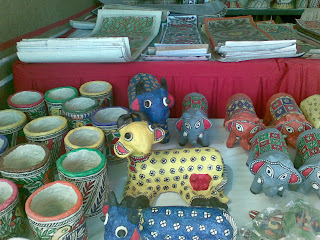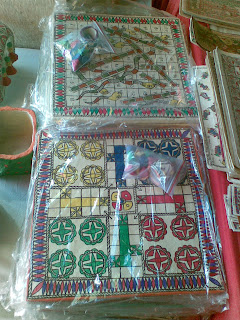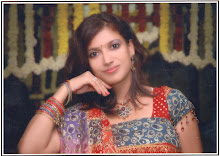Hello Folks !
This post is not just to read...It is to Experience...
There is a Craft Fair in the town and I am all ready to see it.
Come along with me, it'll be fun.
The fair is in the Scindia Palace Campus, a small area called the Moti Mahal .


Here we enter the fair ground.


Hey,do you hear the Folk music playing on the loudspeaker?
NO. Then Play the following video
Wow,I feel like dancing to the Rajasthani folk music...

This is the art work from Rajasthan.Wall hangings,Traditional Dolls and puppets made of cloth and Gota ( silver/golden lace). These days used to decorate interiors.
About Puppets :
Rajasthani Puppets are string marionettes that originate from the state of Rajasthan in India. The puppets are controlled by a single string that passes from the top of the puppet over the puppeteers. Characteristic to this form are the shrill voices produced by the lead puppeteer which are spoken through a bamboo reed. The art of Rajasthani puppetry (also called Kathputli) originated a thousand years ago when the Bhat community began to practice this art. Patronised by many ruling families in the state, it soon grew into a major art form of the region. Due to the invasion of Rajasthan by the Mughals, Kathputli gradually lost its importance. It has been one of the oldest forms of entertainment. Historically, these puppets were not only a source of entertainment, but also provided moral and social education. The shows tackled problems like the dowry system, women's empowerment, illiteracy, poverty, unemployment, andcleanliness. These puppet shows made people aware of the social problems that everybody was facing and also showed ways of solving them.
Source: Wikipedia
Now follows the very delightful craft from Gujarat....Applique and Patchwork wall hangings...

Those little ,rounded,umbrella -like things are lamp-shades....the mirror work on them makes them look attractive.



I wish I had all the accessories and the jewelery boxes too.....


Traditional toys made of wood...Scary Snake !!!


These are Madhubani Art....No, not made by me...My grandmother calls me Madhubani,because she likes this art a lot...and so,my another name is Madhubani.
This art originated in Bihar .It's special because it is made with a paint brush that has a Single hair at the tip to paint....yes, so this is very fine painting.
DID YOU KNOW ? :
The origins of Madhubani painting or Mithila Painting are shrouded in antiquity. Tradition states that this style of painting originated at the time of the Ramayana, when King Janak commissioned artists to do paintings at the time of marriage of his daughter, Sita, to Lord Ram. Madhubani painting has been done traditionally by the women of villages around the present town of Madhubani (the literal meaning of which is forests of honey) and other areas of Mithila. The painting was traditionally done on freshly plastered mud wall of huts, but now it is also done on cloth, hand-made paper and canvas.
As Madhubani painting has remained confined to a compact geographical area and the skills have been passed on through centuries, the content and the style have largely remained the same. Madhubani paintings also use two dimensional imagery, and the colors used are derived from plants. Ochre and lampblack are also used for reddish brown and black respectively.
Madhubani paintings mostly depict nature and Hindu religious motifs, and the themes generally revolve around Hindu deities like Krishna, Ram, Shiva, Durga,Lakshmi, and Saraswati. Natural objects like the sun, the moon, and religious plants like tulsi are also widely painted, along with scenes from the royal court and social events like weddings. Generally no space is left empty; the gaps are filled by paintings of flowers, animals, birds, and even geometric designs.
Traditionally, painting was one of the skills that was passed down from generation to generation in the families of the Mithila Region, mainly by women.The painting was usually done on walls during festivals, religious events, and other milestones of the life-cycle such as birth, Upanayanam (sacred thread ceremony), and marriage.
Source:Wikipedia.

Madhubani Ludo, Madhubani Snakes and Ladders....


Crazzzy Lady!!! Thinks the mirror likes her as much as she likes it.... :)

This is an amazing stall.... Splendid !!!.... "Oye, Dheel de dheel de de re Bhaiya..us patang ko dheel de..."

How I wish I could fly like a kite....!!!

So beautifully decorated and put up..!!!
Interesting Fact:
Kites were first developed in ancient China. Written references to kites in China date back to 200B.C., but they were probably invented at a much earlier time. Kites were probably derived from cloth banners, similar to modern flags, which streamed out in the wind while attached to cords or flexible wooden rods. The first use for kites was probably for signaling at a distance. The Chinese later used kites for numerous purposes, ranging from religious ceremonies to warfare. The earliest kites were built of wood and cloth. Paper was invented around the year 100 A.D. and was soon adapted for use in kites.
Kitemaking soon spread from China to Japan, Korea, Burma (now, Myanmar), and Malaysia, regions where kite flying is still an important part of the local culture. From there it spread to Indonesia, India, and the islands of the Pacific. Eventually, the kitemaking technology was adapted by the Arabs, who in turn brought it to North Africa and Europe.
Source :www.answers.com

These are Scratch paintings...made by scratching the cardboard sheet and coloring in natural colors...The lady at the stall told.


The very Royal Paper mache art !!!

Cute little musical instruments...But can't see any buyers.... youngsters are more keen in learning to play the Guitar...More after watching the movie 'Rock On'...What fate does Indian classical music have?


These physically challenged people made sweet greeting cards and also the following carry bags.

Stunning !!!

This is called ' Best out of Waste '.But now , I wonder how will we save paper???

Children creating jewelery ,doing embroidery and making greeting cards by block printing.

For the first time I'm seeing a potter making earthen pots...I want to try it out too....


The potter giving momentum to the turntable with his stick...


Ooh ! He says only school kids are allowed to try...Nevermind,lets have a look at this hand loom machine and weaver .He is weaving a Sambalpuri Saree and representing the state of Orissa.


Some adjustments need to be made...

Not only hands and eyes , but also feet coordination is compulsory...Hats Off to all Indian Weavers....

FACT :
Sambalpuri Saree is a traditional handwoven Ikkat sari or saree (locally called shari) wherein the warp and the weft are tie-dyed before weaving, produced in the Sambalpur and Dakhin Kosal region of Western Orissa, India. Saree being a traditional female garment in the Indian Subcontinent , a strip of unstitched cloth, ranging from four to nine metres in length that is draped over the body in various styles.
Sambalpuri sarees are known for their traditional motifs, like shankha (shell), chakra (wheel), phulla (flower) with deep symbolism, but the highpoint of these sarees is traditional craftsmanship of the 'Bandhakala', the Tie-dye art reflected in their intricate weaves, also known as Sambalpuri "Ikkat". In this technique, the threads are first tie-dyed and later woven into a fabric, with entire process taking many weeks. These sarees first became popular outside the state, when later Prime Minister, Indira Gandhi started wearing them, soon in the eighties and nineties, they became a popular across India. To provide protection to the weavers practicing this art, the handloom silk sarees manufactured in Sambalpur and Berhampur (Berhampur Pattu) in Orissa would soon be included in the Government of India’s Geographical Indications (GI) registry.
SOURCE :Wikipedia


My favourite ...Red Saree...

Bhai-Bhai....lost and then found each other at the fair :)...the younger one is a bonny sweetheart!!!

I happened to see some of the rarest and most beautiful things here.The whole feel at the trade fair took me to another world....World of Traditional India.

Hope you too enjoyed this craft festival.
Thanks for accompanying me and giving me your precious time.Will surely invite you to the next festival.
:)
















































